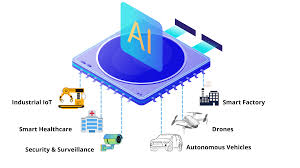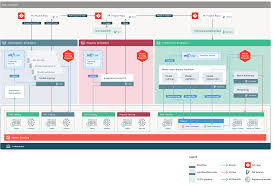1. Introduction — why AI matters for computing:
Artificial intelligence in computing has shifted from niche research to core infrastructure: AI transforming computing through specialized chips, new programming models, and massive data engines. From AI and cloud computing platforms to the machine learning impact on computing workflows, the future of computing with AI is already reshaping how businesses, researchers, and consumers interact with technology.
Artificial intelligence is no longer an optional layer sitting on top of IT — it is a force that changes what computing is. Where computing once emphasized deterministic algorithms, predictable performance and steadily scaling hardware, modern AI workloads demand probabilistic models, massive parallelism, and specialized acceleration. These differences have sparked redesigns across the entire stack: novel chips (GPUs, TPUs, NPUs), new cloud offerings (AI platforms and model hosting), data pipelines built for continuous training and inference, and developer tooling focused on model lifecycle. The result is a dual revolution: AI reshapes computing capabilities and computing enables AI at scale.
Why this matters: businesses can now automate complex cognitive tasks (language, vision, reasoning), researchers can simulate and generate data more rapidly, and consumers experience more natural interfaces. But delivering these benefits requires rethinking cost models, latency trade-offs, reliability engineering, and governance. This article explores how AI transforming computing across hardware, software, operations, and society — and lays out practical guidance and a view of the future.
2. A short history: AI’s integration into computing:
AI’s relationship with computing has evolved in phases:
- Early symbolic AI (1950s–1980s): Rule-based systems running on general-purpose CPUs. Limited by compute and data.
- Statistical ML & rise of GPUs (1990s–2010s): Availability of large datasets and GPUs (originally for graphics) ignited deep learning breakthroughs.
- Cloud & data era (2010s): Cloud providers offered elastic compute and storage; AI models scaled with distributed training.
- AI-native infrastructure (2020s–today): Purpose-built accelerators (TPUs, NPUs), MLOps frameworks, and inference services made AI production-grade.
This timeline shows a gradual move from software-centric AI experiments to co-designed hardware-software platforms optimized for ML workloads. Today’s systems combine algorithmic advances (transformers, diffusion models), massive data, and purpose-built infrastructure.
3. AI hardware revolution: GPUs, TPUs, NPUs and beyond:
One of the most visible changes in computing is hardware specialization for AI:
GPUs (Graphics Processing Units):
GPUs became the workhorse for training neural networks due to their ability to perform many parallel floating-point operations. Modern data centers deploy thousands of GPUs linked via high-speed interconnects (NVLink, InfiniBand) for distributed training.
TPUs (Tensor Processing Units):

Google’s TPUs are ASICs designed specifically for tensor operations that dominate deep learning. They deliver high throughput per watt for matrix multiplications, which accelerates training and inference of large language models and vision models.
NPUs and Edge Accelerators:
Mobile and edge devices increasingly include Neural Processing Units (NPUs) — low-power chips optimized for on-device inference, enabling features like real-time image recognition on phones without cloud latency.
FPGA and Reconfigurable Computing:
Field Programmable Gate Arrays (FPGAs) offer flexibility and can be reprogrammed for specialized AI kernels, particularly valuable in telecom and finance where workloads vary and latency matters.
Interconnects and Memory Innovations:
The bottleneck is often memory bandwidth. High-bandwidth memory (HBM), near-memory compute, and novel interconnect topologies (mesh, torus) help feed accelerators efficiently. Emerging approaches like in-memory compute and photonic interconnects are under research.
Impact on Datacenters and Cloud:
AI accelerators have altered datacenter economics: power density increased, cooling becomes critical, and infrastructure procurement now includes heterogeneous clusters (CPUs + GPUs/TPUs + fast storage). Cloud providers introduced AI instances and managed model services to abstract this complexity.
Practical takeaway: For organizations, investing in the right mix of accelerators or adopting cloud AI instances is key. For developers, awareness of cost and latency trade-offs of different hardware configurations shapes design choices.
4. AI and cloud computing: new service models and economics:
Cloud providers rapidly adapted to AI workloads with specialized services:
Managed Training & Inference:
AWS, Google Cloud, Azure and others offer managed training clusters and inference endpoints with autoscaling. This model lets teams train large models and deploy them without managing clusters directly.
Model-as-a-Service (MaaS) & LLM APIs:
APIs for large language models (LLMs) — hosted by commercial providers and startups — let developers integrate powerful generative AI without owning massive infrastructure. This transforms software economics: teams pay per token/inference rather than upfront hardware CAPEX.
Serverless AI & Edge Cloud:
Serverless options for AI inference simplify deployment and scaling. Meanwhile, edge cloud (regional micro data centers) places compute closer to users for low-latency use cases.
Data Gravity & Data Fabric:
AI workloads pull compute toward large datasets. Cloud providers offer integrated storage, data lakes, and cataloging to reduce data transfer costs and friction.
Cost Considerations:
Training SOTA models can cost millions; inference scale adds ongoing costs. Cloud enables experimentation but requires monitoring, optimization (quantization, pruning, batching) to manage expenses.
Democratization & Vendor Lock-in:
Cloud lowers entry barriers, but reliance on proprietary APIs can create lock-in. Open-source models and frameworks offer alternatives, while hybrid deployments (on-prem + cloud) provide balance for latency-sensitive or regulated workloads.
Practical takeaway: Evaluate whether AI needs justify cloud spend versus hybrid or on-prem approaches. Use managed services for speed-to-market; optimize models for cost at scale.
5. AI at the edge: latency, privacy, and autonomy:
Edge AI processes data on devices or edge servers, enabling:
- Low latency: Critical for AR/VR, autonomous vehicles, industrial controls.
- Privacy: Sensitive data can be processed locally, reducing transfer risk.
- Bandwidth savings: Only aggregated results are sent to the cloud.
Use Cases:
- Autonomous vehicles use edge models for immediate perception and control.
- Smart cameras analyze video streams locally to detect anomalies.
- Industrial IoT runs predictive maintenance models on edge gateways.
Challenges:
- Resource constraints: Edge devices have limited compute and memory.
- Model optimization: Techniques like quantization, pruning, knowledge distillation reduce footprint.
- Management: Over-the-air model updates and monitoring are essential.
Hybrid models — local inference with periodic cloud retraining — are common. Advances in TinyML further push AI into microcontrollers, opening new possibilities for ubiquitous intelligence.
6. Software and developer tooling: frameworks, MLOps, and low-code AI:
AI changes how software is built:
Frameworks & Libraries:
TensorFlow, PyTorch, JAX and others are the backbone for model development. Tooling improved to support distributed training, mixed precision, and model parallelism.
MLOps — model lifecycle management:
MLOps applies DevOps principles to ML: reproducible experiments, CI/CD for models, model registry, automated testing, and monitoring for concept drift. Platforms like MLflow, TFX, Kubeflow, and Sagemaker make productionization easier.
Feature Stores & Data Pipelines:
Feature stores centralize preprocessed features to avoid training/serving skew. Tools like Feast and Delta Lake help maintain consistent features for training and inference.
Low-code / No-code AI:
Citizen-data-scientist tools let domain experts build models without deep ML expertise. While democratizing, these tools must be governed to avoid misuse.
Evaluation, Explainability & Testing:
Testing ML systems requires new strategies: data tests, fairness checks, and explainability tools (SHAP, LIME) to interpret model decisions.
Practical takeaway: Invest in MLOps early. Production ML is maintenance-heavy; tooling reduces risk and accelerates iteration.
7. Data infrastructure: storage, lakes, and feature stores:
AI is data-hungry. Core changes in data infrastructure include:
- Data lakes & lakehouses: Unified storage for raw and curated data (e.g., Delta Lake, Iceberg).
- High-throughput pipelines: Streaming frameworks (Kafka, Pulsar) enable real-time model updates.
- Feature stores: Ensure consistency between training and serving.
- Versioning & lineage: Tools like DVC and Pachyderm provide data version control and reproducibility.
Managing data quality, labeling, and privacy (PII handling) are central operational concerns. Automated labeling, synthetic data, and active learning reduce manual annotation costs.
8. Security, privacy, and robustness in AI-enabled systems:
AI introduces new attack surfaces:
Adversarial Attacks:
Small perturbations can mislead models (e.g., stop sign misclassification). Defenses include robust training and detection mechanisms.
Model Theft and Poisoning:
Model weights can be stolen via model extraction; data poisoning corrupts training data. Secure pipelines and provenance checks are essential.
Privacy:
Techniques like differential privacy, federated learning, and secure multiparty computation enable learning without compromising raw data.
Explainability & Compliance:
Regulations (e.g., GDPR) require transparency. Explainable AI helps auditors and regulators understand decisions.
Operational Security:
ML monitoring must detect drift, degraded performance, and anomalous inputs that may signify attacks.
Practical takeaway: Treat models as first-class assets with security, monitoring, and incident response processes.
9. AI in scientific & high-performance computing (HPC):
AI augments traditional HPC in several ways:
- Accelerated simulations: Surrogate AI models approximate expensive physics simulations.
- AI-guided discovery: In materials science and drug discovery, generative models propose candidate compounds.
- Hybrid workloads: HPC clusters include GPUs/TPUs for both simulation and learning tasks.
This synergy shortens research cycles and reduces computational expense for certain tasks. But reproducibility and validation against physical laws remain critical.
10. Business transformation: automation, personalization, and decisioning:
AI changes business workflows:
- Automation: Robotic Process Automation (RPA) combined with ML automates complex cognitive tasks.
- Personalization: Recommenders and user models enable one-to-one experiences in e-commerce, media, and education.
- Decision intelligence: AI systems augment human decision-making with probabilistic forecasts and scenario analysis.
Organizational impacts:
- New roles: ML engineers, data platform engineers, AI ethicists.
- Cultural shifts: data-driven decisioning requires cross-functional alignment.
- ROI measurement: A/B testing and continuous evaluation quantify value.
Practical takeaway: Start with high-value, low-risk pilots. Scale what yields measurable improvements in KPIs.
11. Environmental impact and efficiency gains from AI:
AI both consumes energy and helps reduce energy use in other domains:
Energy consumption concerns:
Training large models is energy-intensive. However, improvements in hardware efficiency, software optimization, and carbon-aware scheduling mitigate impacts.
Efficiency gains:

AI optimizes supply chains, energy grids, and building HVAC systems, producing net carbon reductions in many deployments.
Green AI movement:
Researchers promote energy-efficient models and reporting on energy cost per training run. Techniques like model sparsity and distillation reduce compute needs.
Practical takeaway: Measure emissions, choose efficient infrastructure, and balance model complexity with environmental cost.
12. Ethics, governance, and regulation for AI-driven computing:
As AI becomes central to computing, governance is imperative:
- Ethical frameworks: Fairness, accountability, transparency.
- Regulation: Governments propose model reporting, AI audits, and sector-specific rules.
- Corporate governance: AI risk committees, model inventories, and impact assessments.
Accountability requires logging decisions, preserving data lineage, and human-in-the-loop controls for high-stakes applications.
13. Case studies: real-world transformations across industries:
Healthcare:
AI models analyze medical images, predict patient deterioration, and prioritize care. Hospitals use AI to triage and assist clinicians, improving outcomes.
Finance:
Fraud detection and automated underwriting use real-time models. Algorithmic risk modeling improves capital efficiency.
Retail & E-commerce:
Personalized recommendations, dynamic pricing, and supply chain optimization reduce waste and increase revenue.
Manufacturing:
Predictive maintenance using sensor data prevents downtime, saving millions.
Government & Smart Cities:
Traffic optimization, energy grid balancing, and public safety analytics improve service delivery.
Each case highlights concrete ROI, but also underscores the need for clear data governance and measurable KPIs.
14. The future of computing with AI — trends to watch:
- Foundation models become ubiquitous: Pretrained models extend to many domains, with specialized fine-tuning for industry tasks.
- Multimodal AI: Models that combine text, vision, audio and sensor data will power richer applications.
- AI-native programming languages and compilers: Abstractions that translate high-level intent into optimized model code and hardware instructions.
- Federated & privacy-preserving learning at scale: Increased on-device learning and collaboration without data sharing.
- Neurosymbolic AI: Combining reasoning with statistical learning for more robust decision-making.
- AI for systems optimization: Systems that self-optimize networking, storage, and compute via reinforcement learning.
- Human-AI co-pilots: Developer and knowledge-worker assistants that dramatically increase productivity.
Implication: Computing will be defined by models as core components, with hardware, software, and policy co-evolving.
15. Practical recommendations for enterprises & developers:
- Start small, measure often: Pilot focused problems with clear KPIs.
- Invest in data and MLOps: Production readiness beats experimental novelty.
- Choose the right infrastructure: Cloud managed AI vs on-prem vs hybrid based on latency, cost, and compliance.
- Optimize models for deployment: Quantize and prune where appropriate.
- Implement governance: Maintain model registries, testing, and explainability.
- Consider environmental impact: Track compute emissions and prefer efficient providers.
For developers, learning modern ML frameworks, distributed training basics, and MLOps practices is increasingly essential.
17. Conclusion:
Artificial intelligence is changing computing at every layer. From specialized hardware and cloud economics to edge autonomy and developer tooling, the integration of AI redefines system design, operations, and business value. The machine learning impact on computing is not just higher throughput — it’s a new way to model, infer, and interact. The future of computing with AI promises unprecedented capabilities but also demands responsibility: security, ethics, environmental stewardship, and careful governance.
Organizations that master data, invest in MLOps, and align AI strategy with business objectives will reap rewards. Developers who learn to optimize for heterogeneous hardware and productionize models will be in high demand. And society must balance innovation with safeguards to ensure AI augments human potential without exacerbating harm.
18. External Links:
- NASA — AI for Earth & climate: https://climate.nasa.gov/
- Nature — AI and computing research: https://www.nature.com/subjects/artificial-intelligence
- IEEE — AI & computing publications: https://ieeexplore.ieee.org/
- MIT Technology Review — AI coverage: https://www.technologyreview.com/
- OpenAI — research & models: https://openai.com
19. Internal Links:
- Featured Ads Featured Ads
- Top Ads WBOLS Top Ads
- WBOLS Classified Website https://wbols.com




Leave a Reply